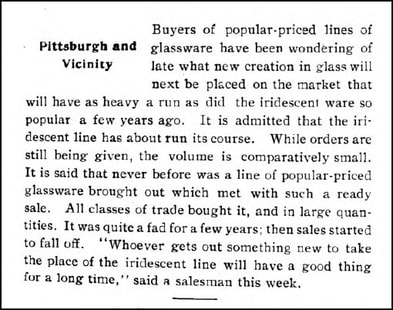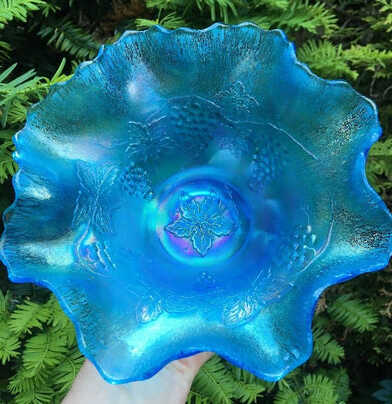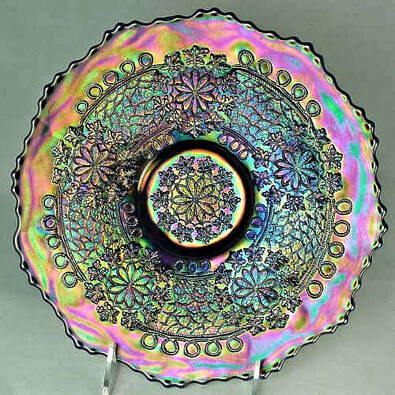NetworK ezine Issue 62. July 2020
Totally Devoted to Carnival Glass
Welcome to the July issue of our free Carnival NetworK ezine.
We hope you are keeping safe and well, and getting much enjoyment from your Carnival Glass during these difficult times.
We hope you are keeping safe and well, and getting much enjoyment from your Carnival Glass during these difficult times.
|
In this issue, we are taking you on a Carnival journey through time; from the early days of Classic Carnival, through the Roaring Twenties (a decade not usually closely associated with Carnival), and on to modern times. Prepare to be surprised and hold on for an interesting ride! There are links to related items of interest, and more detailed images on our website (perhaps more links than usual), but they give you the opportunity to explore little side journeys along the way - all at your leisure! The Dawn of Classic Carnival The dawn of Carnival Glass took place sometime around 1907, and in 1908 the first wholesale ads were seen for the new, mass-produced, iridescent glass. On the right is the first known trade ad for Fenton's Carnival Glass; it was in the September 1908 Butler Brothers catalogue, offering a “ 'Golden Sunset' Iridescent Assortment", with "entirely new beautiful effects". The ad promoted the iridescent assortment as comparable to "exclusive imported lines". A recurring theme in ads at that time was the favourable comparisons between the new (and inexpensive) Carnival Glass, and the upmarket, very expensive alternatives. |
Above: the first known trade ad for Fenton's Carnival Glass, September 1908, Butler Brothers.
|
|
Photo of a Northwood Thin Rib vase in purple, courtesy of Seeck Auctions
|
One of the Fenton patterns featured in this early ad was Waterlily and Cattails. Various shapes were shown in the pattern, including this cute little pulled up vase (sometimes referred to as a toothpick) - see middle row, left hand side. Fenton's marigold Waterlily and Cattails. Courtesy of Seeck Auctions.
On the left is a 1909 ad from a San Francisco newspaper: it described the iridescent vases as “clever imitations of the celebrated Tiffany ware”. The vase featured was a Northwood Thin Rib vase. The artist had taken full licence to "interpret" the vase freely, as the number of ribs/flutes is not illustrated with precision or accuracy on the drawing of the vase. |
|
Also in 1909, one of the new department stores, Panton & White in Duluth, MN, were offering 5000 pieces of Carnival Glass free to their Christmas shoppers - but only to Ladies! Amazingly, this Northwood Blossomtime comport was one of the "FREE OFFERS" for the shoppers! You can see the astonishing ad on our website, in which the glass is described as “not cheap trashy things that will look nice for a day, but real Art Glassware with the decorations baked or burnt in, and guaranteed not to wear off”. Here's the link: Glass Block Store - The Story Behind The Glass Another year later, and Carnival was being described in the glass journals as “popular as ever with the trade”. New lines were being added, the agents’ showrooms were packed with iridescent glass and the 1910 “Crockery & Glass Journal” reported that “sales of the iridescent glass lines during the past season have been the best so far attained”. Here are some more fascinating stories on our website: A photo from August 1911 showing an amazing sight - a New York showroom packed full of glass tableware, water sets, and a "comprehensive line of iridescent ware": Frank Miller's Showrooms Another tantalising photo from 1911 - sales agent Chas J. De la Croix is surrounded by Carnival Glass in the Falmouth Hotel, Portland, Maine: Chas De la Croix |
Marigold Blossomtime comport, courtesy Seeck Auctions
|
On its way out …?
Fast forward just a couple of years and the glass journals were singing a different song, predicting that the popularity of Carnival Glass had started to "fall off"! In 1916, the “Crockery & Glass Journal” stated that “It is admitted that the iridescent line has about run its course” (see extract below, left).
Fast forward just a couple of years and the glass journals were singing a different song, predicting that the popularity of Carnival Glass had started to "fall off"! In 1916, the “Crockery & Glass Journal” stated that “It is admitted that the iridescent line has about run its course” (see extract below, left).
|
The salesman’s suggestion that “whoever gets out something new to take the place of the iridescent line will have a good thing for a long time” is debatable.
Iridescence clearly was not going to be a short-lived fad. By 1916, Carnival Glass was already being made in quantity in Europe, at the Brockwitz and Inwald glassworks – and indeed had probably been in production there for several years prior. Soon production would take place in the UK, in the Nordic countries and in Australia. |
Dugan-Diamond dome-footed Vintage bowl in Celeste blue
|
The worldwide sensation that was Carnival Glass was proving it still had what it takes!
What was Dugan-Diamond’s answer to the flagging Carnival sales? A new, sizzling iridescent colour. It’s a beautiful shade of blue – like a sky blue – and one of the characteristics usually seen on this colour is a stretch effect in the iridescence. The piece shown above (right) is Dugan-Diamond’s Vintage, in the colour that Carnival collectors call Celeste blue. In fact, the name Celeste was Fenton’s choice for this colour, as we will see in the feature below.
The colour has three other names - Cerulean, Vesuvius and Harding Blue? Cerulean Blue was the name attributed to this colour when Dugan-Diamond introduced it in late 1916 - early 1917. An apparently similar shade of blue was then called Vesuvius in the early 1920s – and this exact iridescent colour from Dugan-Diamond is often referred to as Harding Blue (source:1922 “Crockery & Glass Journal”).
In 1919, Harry Northwood died – it was clear his glassworks would not carry on much longer. Millersburg had already closed some years earlier. As the decade drew to a close, what would be the response of the three biggest producers still remaining – Fenton, Dugan-Diamond and Imperial? The answer? They carried on, and they broadened their markets.
|
The Roaring Twenties
In the early years of Carnival production, Classic USA Carnival was exported to both the UK and Australasia, but World War One put international trade on hold. As the Twenties opened up, so did export markets and once again American Carnival Glass was being promoted and widely sold in Britain and in Australasia. Fenton, Dugan-Diamond and Imperial all marketed their iridescent glass far and wide. Imperial’s Carnival featured heavily in the early 1920s ads of a merchant in Australia - Reub Levy, the self-styled "King of China". Levy had a vast amount of Carnival at his disposal, which he promoted heavily, using fascinating - and amusing punch lines. He offered "Solid, Substantial Values" and "No HUMBUG-no tricks-no excuses- but a fair, square, straight deal"! In September 1920 this ad (right) appeared in the Australian press under the byline: " 'Sunkist’ Table Glassware". Click on the image, or here, to explore Levy's advertising creativity and see the ad full size: "Never Judge a Sausage by its Shiny Overcoat" In the UK, both Fenton and Dugan had agents on the ground who were heavily promoting sales of their Carnival. Shown below is a fascinating ad that (to the best of our knowledge) has not been reported before. It appeared in the 1922 “British Pottery Gazette & Glass Trade Review” as part of a large ad for the British American Glass Co., Limited, of Holborn, London (agents for Dugan-Diamond). |
The two items shown here are part of the “Golden Iridescent Series” with the added info “new shapes have been added and we are able to offer really big value”. The items in the ad were Dugan-Diamond’s Double Stem Rose and Cosmos Variant, both of which were later patterns from Dugan-Diamond (produced in the Diamond years from c.1917). Note how each one was referred to in the ad as a “Golden Receiver” – indicating they were marigold in colour. We can only assume that “receiver” implied a card receiver, for storing calling or visiting cards. It’s somewhat curious, as we are not aware of this term being used much in the UK at that time. Left: Double Stem Rose (far left) and Cosmos Variant, both in marigold. Courtesy Seeck Auctions. |
In 1922, Dugan-Diamond’s pieces also appeared in Butler Brothers’ catalogues in the USA, featuring Double Stem Rose and Cosmos Variant, plus the well-known Cherries bowl (top left in the ad below, right).
|
Fenton also advertised heavily in the UK, and reports from the Fenton agent’s showrooms (Charles Pratt of the National Glass Co., Ltd) made for interesting reading. In 1925 it was reported in the “Pottery Gazette” that Pratt had recently returned from America “full of enthusiasm” for the glass he saw there. His showrooms in London offered glass: “In the old iridescent ware, which was at one time chiefly supplied in a golden orange tint, a new celeste blue, having a kind of satin sheen finish ...” |
Left: a Fenton Persian Medallion bonbon in Celeste blue |
In 1923, Australians were lucky enough to be offered Fenton’s Carnival Glass as free gifts when they collected Bushell’s Tea coupons - the catalogue page is shown below, courtesy of Gary Workman.
|
"Bushells Bonus Presents" offered various Fenton items. The Leaf Chain pattern (shown below) was but one of them - what a bonus for buying their tea!
Fenton 9" Leaf Chain plate, blue
Carnival Collectors may recognise another pattern in the Bushells ad - Fenton's Two Flowers - but the surprise is that it was also offered in an Australian department store's catalogue in 1923 - here is an extract from the catalogue: To see the full advert, click on the image, or here: Foy & Gibson.
|
|
Fast Forward …
In 1931, Dugan-Diamond (which, in fact is correctly called the Diamond Glassware Company post 1913) closed following a devastating fire. Some eight years later, moulds from the glassworks were purchased by Si Wright (of L. G. Wright Glass) from John Richards, an Indiana businessman*. Wright had Carnival made by Westmoreland and Fenton from several of these moulds. Then, in more recent years, Fenton subsequently acquired a number of these moulds and made their own versions of some of these iconic pieces, several of which can be seen here. A coming-together, a symbiosis – the old and the new. Golden Harvest was another Dugan-Diamond pattern that was made again in Contemporary Carnival by Fenton. On the left is an amethyst decanter, made in 2002, and on its right is the same item made in 2008 in "Autumn Gold".
The caption in the Fenton catalogue gave the following information about it: “This gorgeous 12” Autumn Gold Grape Decanter was produced from an L.G. Wright mould and purchased by Fenton from Wright in 1999. Wright had moulds made based on old carnival glass patterns from Imperial and Dugan. Lots of old carnival glass motifs involved grapes. A real attention grabber when placed on a sideboard or hutch.” Right: Fenton’s 2009 version of Dugan-Diamond’s Dogwood Sprays bowl. |
Above: a Contemporary Stork and Rushes water set in red Carnival, made by Fenton in 2005.
|
* Source, “The L. G. Wright Glass Company” Roetteis & Measell, 1997
So there we have it - the remarkable story of Carnival Glass from its dawn in 1907 right through to the 21st Century production!
So there we have it - the remarkable story of Carnival Glass from its dawn in 1907 right through to the 21st Century production!
Privacy and the use of your information: we only use your name and email address to send you your FREE Carnival Glass NetworK ezine. We will not share your name or email address with anyone else, or use it for any other purpose. You can change your mind about receiving your NetworK ezine at any time by clicking the unsubscribe link at the foot of every issue, or by emailing us at [email protected]
Join us on Facebook
We would love you to come and join in the fun, and we invite you and your friends to join us all on NetworK's fast growing and very active Facebook Group (link is below), and if you have missed any of the previous issues of NetworK and NetworK Specials, they are all here: Back Issues.
We would love you to come and join in the fun, and we invite you and your friends to join us all on NetworK's fast growing and very active Facebook Group (link is below), and if you have missed any of the previous issues of NetworK and NetworK Specials, they are all here: Back Issues.



















